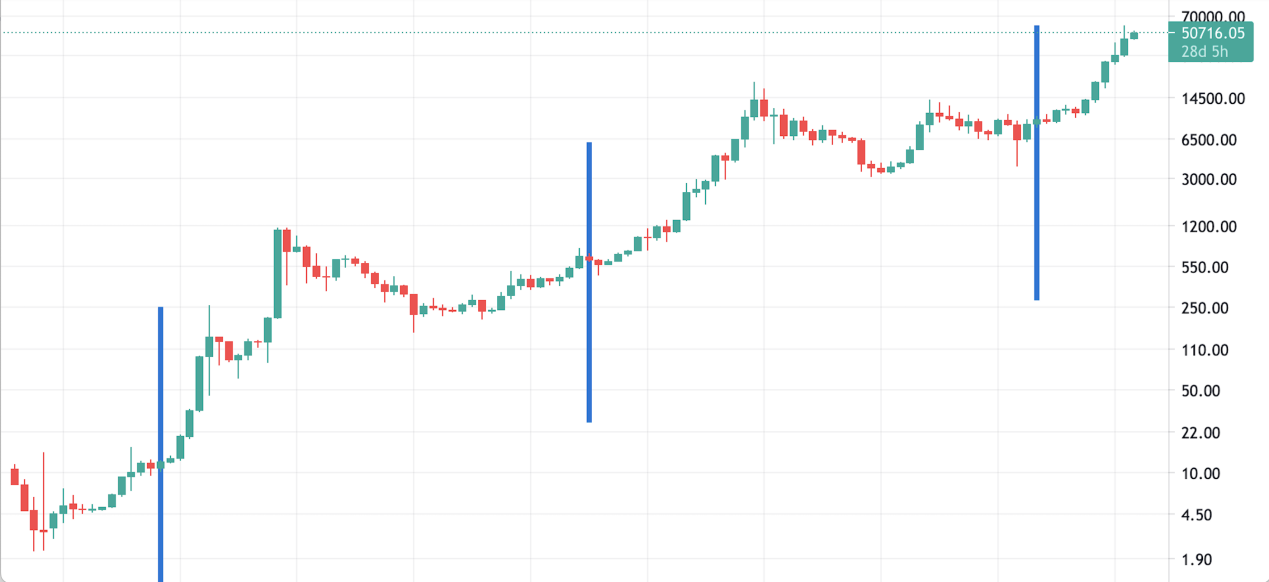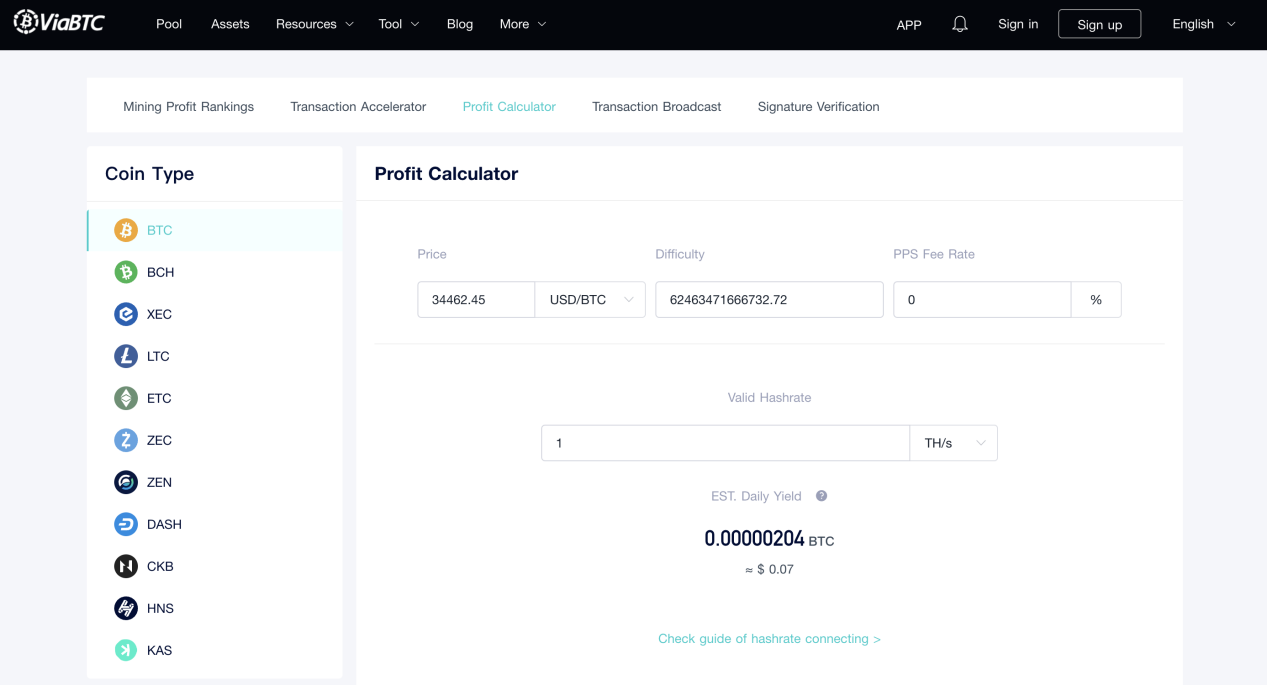
BTC Halving Explained
BTC halving is a pre-determined event that occurs approximately every four years or after every 210,000 blocks until the total supply of BTC reaches 21 million. Although Satoshi Nakamoto, the father of Bitcoin, did not explicitly explain the reasons behind the halving mechanism, it is widely speculated that the initial 50 BTC reward was designed to incentivize miners to quickly join the network and mine new blocks, enabling fast market circulation
The first BTC halving occurred on November 28, 2012, reducing the block reward from 50 BTC to 25 BTC. At the time, the BTC price hovered around $12, and within a year, it surged by nearly 9,000%.
The second halving took place on July 10, 2016, slashing the reward from 25 BTC to 12.5 BTC. Following the second halving, the BTC price plummeted to $650, but by December 2017, the figure reached an all-time high of about $19,700, a jump of almost 3,000%.
The third BTC halving, which happened on May 12, 2020, lowered the reward from 12.5 BTC to 6.25 BTC. Back then, the BTC price fluctuated around $10,000. By November 2021, the price reached a record high of nearly $69,000, a 590% increase.

The three blue lines correspond to the three halvings in 2012, 2016, and 2020.
Profitability of New ASIC Mining Rigs
We can assess the profitability of new mining rigs released by manufacturers with the Profit Calculator, a tool provided by ViaBTC Pool. Let’s assume the electricity cost to be $0.05 per kWh, based on data recorded on November 1 (BTC price: $34,462.45 & network difficulty: 62.46 T), we can get the following results:

Source: https://www.viabtc.com/tools/calculator
MicroBT’s Latest ASIC Miners (to provide you with a brief overview, only a selected few will be introduced):
WhatsMiner M63S (390T)
Rated hashrate: 390 TH/s
Rated power: 7,215W
Official price: $10,530
Daily profit: $27.55 (daily revenue) - $8.66 (electricity cost) = $18.89
Payback period: $10,530/$18.89 = 557 days
WhatsMiner M63 (366T)
Rated hashrate: 366 TH/s
Rated power: 7,283.4W
Official price: $9,150
Daily profit: $25.86 (daily revenue) - $8.74 (electricity cost) = $17.12
Payback period: $9,150/$17.12 = 534 days
WhatsMiner M66S (298T)
Rated hashrate: 298 TH/s
Rated power: 5,513W
Official price: $8,046
Daily profit: $21.05 (daily revenue) - $6.62 (electricity cost) = $14.43
Payback period: $8,046/$14.43 = 558 days
WhatsMiner M66 (280T)
Rated hashrate: 280 TH/s
Rated power: 5,572W
Official price: $7,000
Daily profit: $19.78 (daily revenue) - $6.69 (electricity cost) = $13.09
Payback period: $7,000/$13.09 = 535 days
BITMAIN’s Latest ASIC Miners
Antminer S21 Hyd.
Rated hashrate: 335 TH/s
Rated power: 5,360W
Official price: $11,725 (with the 30% discount offered on BITMAIN’s official website, the model is currently priced at $8,207.5)
Daily profit: $23.67 (daily revenue) - $6.43 (electricity cost) = $17.24
Payback period: $8,207.5/$17.24 = 476 days
Antminer S21
Rated hashrate: 200 TH/s
Rated power: 3,500W
Official price: $7,000 (with the 30% discount offered on BITMAIN’s official website, the model is currently priced at $4,900)
Daily profit: $14.13 (daily revenue) - $4.20 (electricity cost) = $9.93
Payback period: $4,900/$9.93 = 476 days
Canaan’s Latest ASIC Miners
Avalon A1466I
Rated hashrate: 170 TH/s
Rated power: 3,315W
Third-party price: $3,699
Daily profit: $12.01 (daily revenue) - $3.98 (electricity cost) = $8.03
Payback period: $3,699/$8.03 = 461 days
It should be noted that the above results are theoretical figures and do not account for price swings or difficulty adjustments.
Who Will Be the Biggest Winner of BTC Halving?
As the Bitcoin halving approaches, we wonder who will be the biggest winner. Will it be holders, miners, mining rig manufacturers, or mining pool operators? If, as expected by many, the BTC price continues to surge, possibly surpassing previous peaks, all stakeholders stand to profit and can be considered winners.
However, the Bitcoin halving comes with both risks and opportunities. If the price falls short of market expectations, or if the price plummets due to an unexpected black swan event, coupled with the impact of the halved block reward, most mainstream mining rigs may approach their shutdown prices. This will trigger a domino reaction. Miners who invested heavily in mining rigs before the halving will face a rough start, with a prolonged payback period.
In summary, the next Bitcoin halving will definitely happen and is expected to occur around April 24, 2024. The halving mechanism benefits Bitcoin by preserving its scarcity and value. It allows people to have faith in the coin’s long-term prospects. Unlike the speculators out there, Bitcoin miners believe in the long-term value of BTC. The next bull market is just on the horizon, as long as miners maintain their confidence and consensus.
*The article offers no financial advice.